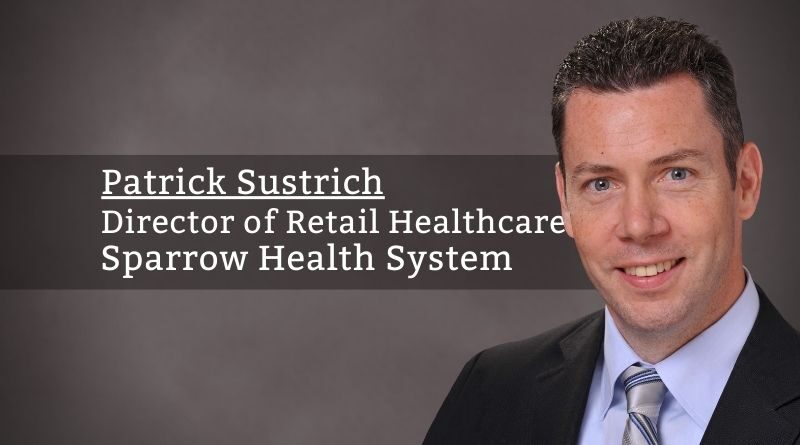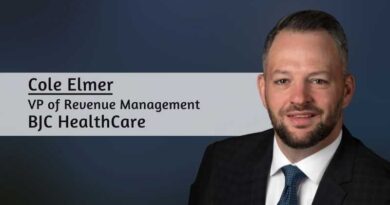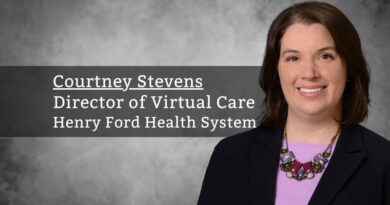When Optional Becomes Essential: Virtual Health
By Patrick Sustrich, MS, Director of Retail Healthcare, Sparrow Health System
As was true for most persons in the U.S. in March 2020, essentially, the only way to have a visit with a provider at Sparrow Health System was in-person. You would either need to call the office to make an appointment or drive to one of our urgent care/walk-in clinics. This laborious process would require you to change out of your pajamas, have reliable transportation, drive around looking for parking, wait in the waiting room, be placed in a gown, and wait to be seen in a too-often cold exam room. One month later, in April 2020, Sparrow conducted 3,132 video visits and 22,514 telephone visits. What changed? COVID-19!
We assembled our virtual health strategy in October 2019 with a target date to begin on-demand virtual urgent care visits in the third quarter of 2020. Not long ago, standing up a single virtual health offering in one year was considered agile. Our strategy began by aligning virtual health as a “tool” to improve access and positively impact the Quadruple Aim (reducing costs; improving population health, patient experience and caregiver well-being), although great change is not without significant resistance. Providers were skeptical, with questions and comments that ranged from, “How can you diagnose and treat a patient without a physical examination?”, “Virtual health is not real medicine,” “Patients will never go for this; they want to be seen in person.” and “Insurers won’t pay for this kind of care.” The COVID-19 pandemic changed everything, including policy changes, reimbursement and immediate acceptance of virtual health by providers and patients. During this time, we proved that health systems could be nimble and act quickly – making technology available in days rather than months or years. Once providers and patients became comfortable with the “tool,” they began seeing its value.
Our goal in 2022 is to reduce medical advice requests by 50% by converting many of these into E-Visits. The response by patients has been positive.
During the third week in March 2020, not only did we set up scheduled video visits, but we made on-demand video visits available 12 hours a day, seven days a week, staffed by our urgent care/walk-in clinic providers. It wasn’t long before our Emergency Departments had the capacity for more patients and were looking for ways to keep their core staff busy. We added five of our Emergency Departments to the on-demand platform and expanded access to 24/7 care. At that time, we had anywhere from 8-15 Sparrow providers available for walk-in or virtual visits at any given time – and patients loved it! The video visits were initiated through our EMR and conducted by Sparrow providers who had access to the patient’s medical record, and documentation occurred within the EMR. Our completion rate was over 80%, the average wait time was under 15 minutes, and everything was great – until the third wave of COVID in fall 2021. This wave was much different than the previous two in that businesses were open; people were not social distancing, schools were back in-person, and subsequently, in-person patient volume was ramping back up. Because of this, wait times for our on-demand virtual platform began increasing, and completion rates plummeted. We once again found ourselves with a new challenge in balancing high in-person volume and managing our on-demand virtual platform. We quickly dedicated two providers to the on-demand platform to cover Monday through Saturday from 8 a.m. to 8 p.m. The Sparrow Hospital Emergency Department added resources and continued to provide after-hour coverage Monday through Saturday, 8 p.m. to 8 a.m. and all day Sunday. The remaining urgent care/ walk-in clinic providers continued to provide backup support. We added completed on-demand video visits to the urgent care/walk-in clinic providers’ quality goals, which proved to be one of the most effective tactics in virtual patients being seen quickly. Full-time providers must conduct 132 video visits annually to obtain full credit for this quality goal.
After launching provider-to-provider virtual consults, patient-to-provider inpatient video visits, virtual behavioral health and virtual connection between our Community Hospitals with Sparrow Hospital, we recently initiated E-Visits. E-Visits are an asynchronous portal exchange between a provider and their patient. We rolled this out in summer 2021, starting with primary care providers for nine minor acute conditions, and expanded it to our specialists in the following months. The vision for E-Visits was more than access; it was to provide compensation for the work many providers were already doing by responding to medical advice requests that required significant medical decision-making. In fact, over 6,000 medical advice requests escalated to providers each month. Our goal in 2022 is to reduce medical advice requests by 50% by converting many of these into E-Visits. The response by patients has been positive. Because patients complete eCheck-in and answer a prescribed questionnaire, it feels like a visit, but the patient can submit it when and where they want to, rather than needing an appointment or waiting in line. E-Visits have been a great addition to Sparrow’s virtual health ‘’toolbox.’’
Today, two years after the start of the pandemic, in addition to in-person visits, Sparrow providers and patients can utilize on-demand and scheduled video visits, telephone visits, and E-Visits at their convenience. During a recent snowstorm that closed clinics at 2:00 p.m., hundreds of in-person visits were quickly converted to video visits, ensuring that patients received care without driving in treacherous weather conditions. Beyond COVID, these resources will continue to provide value in the future.
COVID will forever change our lives, and at least some of it will include additional convenient options for safe, effective health care.



